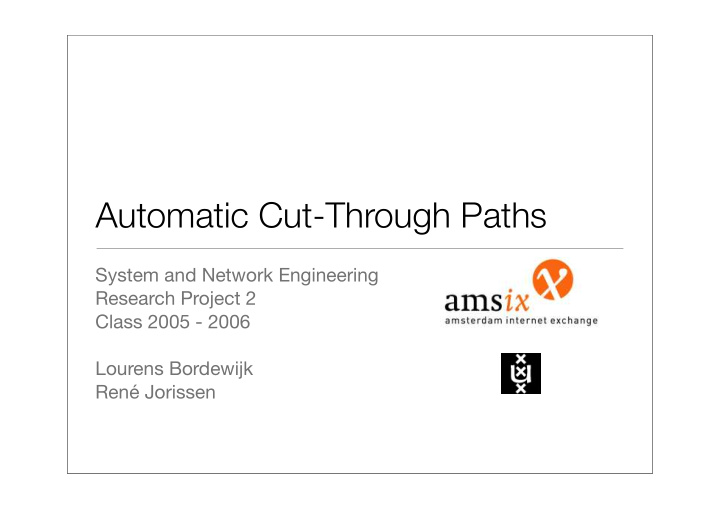



Automatic Cut-Through Paths System and Network Engineering Research Project 2 Class 2005 - 2006 Lourens Bordewijk René Jorissen
Agenda ‣ AMS-IX network ‣ Problem definition ‣ Cut-through path ‣ RBridges ‣ Additional solution ‣ Conclusion
AMS-IX network (1) NIKHEF SARA Telecity Global Switch psw-nik-03 psw-sar-02 psw-tel-03 psw-nik-02 psw-sar-01 psw-tel-02 psw-nik-02 stub-nik-05 stub-nik-06 stub-sar-01 stub-sar-02 stub-tel-02 stub-tel-03 stub-glo-01 stub-glo-02 RX16 MG8 MG8 RX8 RX16 MG8 MG8 RX8 core-nik-04 core-tel-03 RX16 RX16 edge edge edge BI15K edge edge edge BI15K BI15K BI15K BI15K edge BI15K BI15K Customer <= 1 GE Customer <= 1 GE Customer <= 1 GE Customer <= 1 GE
AMS-IX network (2) ‣ VLANs - Internet, multicast... - Quarantine ‣ Virtual Switch Redundancy Protocol - Foundry Networks proprietary
AMS-IX network (3) ‣ Customer statistics - Number of customers: 240 - Number of routers: 390 ‣ Traffic statistics - Average load: 90 Gb/s - Peak load: 150 Gb/s
Problem definition (1) ‣ Cut-through switching ‣ Layer two network - Loops - Broadcast - Spanning tree
Problem definition (2) ‣ Management - Thresholds - Sampling - Computation - Configuration
Cut-through path (1) ‣ Why - Lessen load on core switches - Lessen traffic congestion - Involves less jitter - More bandwidth capacity - More efficient traffic streams
Cut-through path (2) ‣ How - Sampling process - Filtering process - Trigger - Control server architecture
sFlow (1) ‣ What - Packet-based sampling technology - From layers two till seven - Provide information about switch ports, MAC addresses, VLANs, IP addresses and ICMP/TCP/UDP/AS-based information
sFlow (2) ‣ Why - Supported by the Foundry switches - Inspecting all packets costs extensive CPU power - Can handle volume of high speed backbone links - Provides a result with quantifiable accuracy
Resource information ‣ SNMP - Data transfer - CPU utilization, memory utilization - CAM statistics and process utilization - Logging
Sampling process ‣ When - A load of more than 90% for 30 minutes on a certain switch port - A constant data flow of more than 4 Gb/s for 30 minutes on a certain switch port - Determine the exact values after further research
Filtering process (1) ‣ How - Starts when first sFlow data from a switch is collected SSwitch DSwitch VLAN SPort DPort SMAC DMAC Count Priority STime TTL
Filtering process (2) ‣ Sort flows based on priority and packet count - Per DSwitch, than per SPort & SSwitch and than per VLAN - “Priority & packet count” must reach threshold before the TTL ends, (decisions taken after TTL period)
Filtering process (3) ‣ Combine the total flows per SPorts from the SSwitch - Calculate average
Filtering process (4) ‣ Example: TTL
Bandwidth prediction ‣ Traffic cycle ‣ Several algorithms for bandwidth prediction ‣ Forecast traffic flows with long lifetime - Use for setting priority
Cut-through creation (1) ‣ How (1) - Huge amount of traffic is flowing between two customers - Flow triggers cut-through path creation - Create a new VLAN - Photonic switch connects two edges
Cut-through creation (2) ‣ How (2) - Create MAC filter based on destination MAC addresses - Configure an egress filter on switch port • Encapsulate Internet VLAN tagged frames with the new VLAN tag • 802.1ad (Provider Bridges)
Cut-through creation (3) ‣ How (3)
Control server architecture (1) ‣ Why - To collect data - Consider the priorities - Makes calculations - Automatically configures a dynamic cut-through path - To manage all resources
Control server architecture (2) ‣ How - Separate networks, one private - Control process must be physically separated from the filtering process - Validate all configuration steps (roll back) - Control server should be redundantly for failover in the event of a system failure
Control server architecture (3)
RBridges (1) ‣ Transparent Interconnection of Lots of Links (TRILL) ‣ Problems ‣ Required properties - Inefficient paths - Services - Convergence - Loop mitigation - Backup paths - VLAN - Ethernet extensions - Security
RBridges (2) ‣ Advantages of routers and bridges ‣ “Routing” on layer two ‣ Full mesh possible ‣ Ethernet frame encapsulation ‣ Hardware or firmware ‣ Approximately 2 years
RBridges (3) ‣ General operations - Peer and topology discovery - Designated RBridge election - Ingress RBridge Tree computation - Link-state routing - Advertisements
RBridges (4) ‣ Ingress / Egress RBridge - Encapsulation - Decapsulation
RBridges (5) ‣ Hop-by-hop vs. edge-by-edge - Different headers ‣ Forwarding - Unicast R2 - Broadcast R1 R3 - Multicast
Additional solution (1) ‣ Two uplinks - Secondary path - Adding customer routing tables
Additional solution (2)
Conclusion (1) ‣ Capacity problem (approx. in 1,5 year), best solution? - 100 Gb/s capable switch ports ‣ RBridges - Full mesh layer two topology - Uses all paths efficiently - No STP and VSRP needed - 1 to 2 years
Conclusion (2) ‣ Interim solution could be the use of VLANs - Automatically configured cut-through VLANs, when specific traffic flow reaches threshold - Control architecture takes care of the sampling, filtering, computation and triggering process
Future ‣ Further research to determine thresholds ‣ Development software ‣ Build test environment ‣ Other technologies - GMPLS • Looks like a solution • No hardware support
Questions Thanks for the attention
Recommend
More recommend